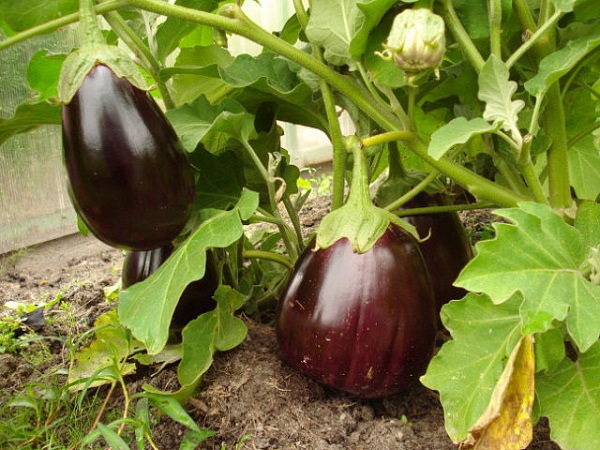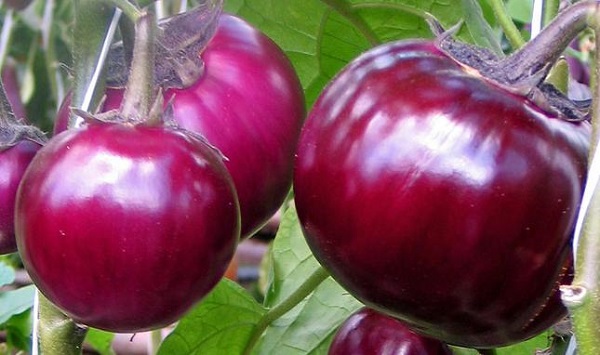Top 7 varieties of eggplant for a polycarbonate greenhouse
Content
Nutcracker
Medium early hybrid with a relatively high yield. A feature of this variety is the regular formation of the ovary, even at the very top of the bush, due to which the eggplant harvest can be harvested several times - the average yield is 4-6 kg / 1 plant.
The bushes are slightly spreading, reaching a height of 70-80 cm. Fruits are oval, short (12-15 cm), but wide in diameter, dark purple, one might even say black. The average weight of the fruit is 250-500 g. The pulp is white, firm, does not contain bitterness. They are excellently transported, preserved for a long time, and at the same time the pulp does not become friable.
The hybrid is intended exclusively for the greenhouse. Fruiting in about 40 days after transplanting. Seedlings should be transplanted into a greenhouse at the beginning of June, but under a polycarbonate cover it is possible even earlier. The culture is considered unpretentious, however, regular watering and a constant temperature are required for it. Plant growth can be stimulated with periodic hilling and fertilization.
Video "The best varieties and hybrids of eggplant"
This video shows an overview of some of the eggplant varieties.
Bagheera
Mid-early hybrid - the ripening period is 100-110 days from the day of sowing seeds for seedlings. A distinctive feature of the variety is its high yield (10-12 kg / 1 sq. M) and the simultaneous ripening of fruits. The hybrid is quite resistant to diseases, but demanding of constant temperature and humidity.
The culture was bred specifically for closed ground. In greenhouses it is customary to grow it according to the so-called "low-volume" technology - in separate small containers with a special substrate, which is very convenient in a small greenhouse.
The variety is compact bush. Fruits are oval, rather long, widening towards the bottom, intense purple or bluish-black color, weighing 250-350 g. Fruits are distinguished by good taste and long shelf life. The pulp is firm, slightly greenish. Young fruits are not bitter at all, however, over time, the pulp begins to taste bitter. Suitable for any dishes and preparations.
Purple miracle
The most famous and favorite hybrid of vegetable growers. Such popularity of the variety is due to its versatility and unpretentiousness. The plant feels great and bears fruit, both in greenhouse conditions and in the garden. The culture is resistant to almost all diseases, it can tolerate temperature extremes, and what is most interesting, at any stage of growth, plants are not susceptible to light - they do not need a long day of light and additional illumination. Due to this quality, the Purple Miracle can be grown in northern regions.
The variety belongs to the early maturing - the first harvest ripens in 95-105 days. Fruits are short, but wide in diameter (each weighs 230-300 g), dark purple in color with a smooth glossy rind. The pulp is white, slightly greenish, the bitterness is completely absent, which allows you to use vegetables for any dishes and processing.The yield is quite high - 6.5-8 kg / 1 sq. m. Well transported, easy to harvest, since the stems and peduncles are completely devoid of thorns.
Baikal
A mid-season (100-110 days) hybrid, characterized by an impressive size of bushes (1.2 m in height). Suitable for growing in any greenhouse. It is quite resistant to diseases and unpretentious in care, but for normal development it is necessary to constantly maintain humidity. The yield of the variety is 6-8 kg / 1 sq. m landing.
The fruits are rather large (300-350 g), long, sometimes pear-shaped or slightly curved. The color of the eggplant is dark purple with a smooth and shiny surface. The pulp is greenish, dense, with a minimum number of seeds and without characteristic bitterness. The fruits are transportable, suitable for cooking and processing.
Joker
A feature of this variety is an unusual type of fruiting - carpal, when 4-7 fruits are formed and ripen from one cluster at the same time. The hybrid belongs to the early (the period of fruit ripening is 85-100 days), and has an unusually high yield - 50-70 eggplants can be immediately removed from one bush.
The fruits of this unusual variety are also very interesting: oval, slightly elongated, painted in a bright purple color. Sometimes there are specimens with a darker purple color - this is possible if different eggplant hybrids are planted together. The weight of the fruits is small (80-130 g), the peel is rather thin and smooth, the flesh is white, dense, and has a pleasant taste.
Tall bushes - in polycarbonate greenhouses they can grow up to 1.2-1.5 m, so they need to be tied up. It will not be possible to do without tying in a greenhouse, since the plants are very overloaded with fruits (up to 100 pieces can ripen on one bush). The culture is immune to various diseases and infections. The yield of the variety is high.
Fabina
A very early hybrid intended for indoor use, however, under suitable conditions, it grows well in the garden. Fruiting occurs very early - 70-90 days from the day of sowing. Plants are compact, open type, the height of the bushes is 45-65 cm, 7-8 fruits are formed at the same time. The eggplant yield is relatively high - 5-7 kg / 1 sq. m landing.
Fruits are medium in size (180-220 g), long (20-25 cm), cylindrical, dark purple, sometimes even black. The surface of the fruit is smooth and shiny. The pulp is slightly greenish, dense; young fruits have no seeds at all. The taste of vegetables is quite unusual - with a mushroom flavor, which is why they are often used in Caucasian cuisine.
Transportability and safety of eggplants are high. The culture is resistant to pests (spider mites), diseases, especially verticilliosis. The purpose of the fruits is very different - from snacks and second courses to pickling, pickling and even freezing.
Black handsome
The variety belongs to the mid-season - the first harvest can be removed only after 120-145 days from seed germination. It grows and bears fruit equally well in greenhouses and in the open ground of the southern regions. The yield of the variety is very high - 10-12 kg / 1 sq. m. The plant is resistant to disease, loves moist and fertile soil.
Bushes are compact, low (60-80 cm), stems and leaves with thorns. A rare feature of this type of eggplant is the formation of an ovary in the lower part of the bush, and being in full shade, the vegetables ripen perfectly regardless of the weather and the amount of light.
Fruits are medium in size (180-250 g), have an elongated pear-shaped shape, rather wide in diameter. The color of the peel in technical ripeness is intense purple; as it ripens, the vegetable turns purple-black. The pulp is firm, slightly greenish or yellow, delicate in taste, without bitterness. Eggplants retain their presentation for a long time.
For eggplants, polycarbonate greenhouses create ideal growing conditions.They are able to maintain a constant temperature, reliably protect against winds, temperature changes and night frosts. If vegetables in such conditions are provided with full watering, then you can get an eggplant yield that is much higher than from open ground.
Video "Eggplant"
Some of the features of growing eggplant are described in this video.








